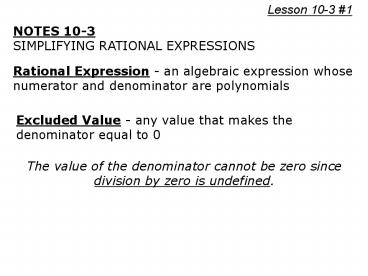Rational Expression - an algebraic expression whose numerator and denominator are polynomials - PowerPoint PPT Presentation
1 / 40
Title:
Rational Expression - an algebraic expression whose numerator and denominator are polynomials
Description:
Lesson 10-3 #1 NOTES 10-3 SIMPLIFYING RATIONAL EXPRESSIONS Rational Expression - an algebraic expression whose numerator and ... – PowerPoint PPT presentation
Number of Views:568
Avg rating:3.0/5.0
Title: Rational Expression - an algebraic expression whose numerator and denominator are polynomials
1
Lesson 10-3 1
NOTES 10-3
SIMPLIFYING RATIONAL EXPRESSIONS
Rational Expression - an algebraic expression
whose numerator and denominator are polynomials
Excluded Value - any value that makes the
denominator equal to 0
The value of the denominator cannot be zero since
division by zero is undefined.
2
Lesson 10-3 2
Find any excluded values.
3
Lesson 10-3 3
Simplify each rational expression, if possible.
Identify any excluded values.
4
Lesson 10-3 4
To simplify fractions, divide out common FACTORS
(not terms) that are in both the numerator and
the denominator.
A rational expression is in its simplest form
when the numerator and denominator have no common
factors except 1.
5
Lesson 10-3 5
From this point forward, you do not need to
include excluded values in your answers unless
they ask...
Simplify each rational expression, if possible.
6
Lesson 10-3 6
7
Lesson 10-3 7
8
Lesson 10-4 1
NOTES 10-4
MULTIPLYING AND DIVIDING RATIONAL
EXPRESSIONS
The rules for multiplying rational expressions
are the same as the rules for multiplying
fractions. Multiply across!
9
Lesson 10-4 2
Multiply. Simplify your answer.
10
Lesson 10-4 3
11
Lesson 10-4 4
12
Lesson 10-4 5
13
Lesson 10-4 6
The rules for dividing rational expressions are
the same as the rules for dividing fractions.
To divide, multiply by its reciprocal!
14
Lesson 10-4 7
Divide. Simplify your answer.
15
Lesson 10-4 8
16
Lesson 10-4 9
17
Lesson 10-6 1
NOTES 10-6
DIVIDING POLYNOMIALS
When the denominator is a monomial put each term
of the numerator over the denominator.
(5x3 20x2 30x) 5x
(8p3 4p2 12p) (4p2)
18
Lesson 10-6 2
If the denominator is a polynomial just FACTOR
AND SIMPLIFY!
19
Lesson 10-6 3
Recall how you used long division to divide whole
numbers as shown at right. You can also use long
division to divide polynomials. An example is
shown below.
(x2 3x 2) (x 2)
20
Lesson 10-6 4
Using Long Division to Divide a Polynomial by a
Binomial
1) Write in standard form.
2) DIVIDE the first term of the dividend by the
first term of the divisor. This the first term of
the quotient.
3) MULTIPLY this first term of the quotient by
the binomial divisor and place the product under
the dividend, aligning like terms.
4) SUBTRACT the product from the dividend.
5) BRING DOWN the next term in the dividend.
6) Repeat Steps 2-5 as necessary until you get 0
or until the degree of the remainder is less than
the degree of the binomial.
21
Lesson 10-6 5
(x2 10x 21) (x 3)
When the remainder is 0, you can check your
answer by multiplying it by the divisor. You
should get the numerator.
22
Lesson 10-6 6
Sometimes the remainder is not 0. The remainder
can be written as a rational expression.
Divide (3x2 19x 26) (x 5)
23
Lesson 10-6 7
24
Lesson 10-6 8
Write the polynomials in standard form first. If
you have a missing term, use a placeholder.
Divide (x3 7 4x) (x 3).
25
Lesson 10-6 9
(1 4x2 x3) (x 2)
26
Lesson 10-5 1
NOTES 10-5
ADDING AND SUBTRACTING RATIONAL
EXPRESSIONS
The rules for adding rational expressions are the
same as the rules for adding fractions.
If the denominators are the same, add the
numerators and keep the common denominator.
27
Lesson 10-5 2
Add. Simplify your answer.
28
Lesson 10-5 3
29
Lesson 10-5 4
Add the opposite of each term in the numerator of
the second expression when subtracting.
30
Lesson 10-5 5
To add or subtract fractions, you need a common
denominator the least common multiple (LCM) of
the denominators.
Ask What do I have? What do I need?
31
Lesson 10-5 6
Find the LCM of the given expressions.
12x2y 9xy3
c2 8c 15 3c2 18c 27
32
Lesson 10-5 7
Adding or Subtracting Rational Expressions
1) Identify a common denominator.
2) Multiply each expression by a Designer 1 so
that each term has the common denominator.
3) Write each expression using the common
denominator.
4) Add or subtract the numerators, combining like
terms.
5) Factor as needed.
6) Simplify as needed.
33
Lesson 10-5 8
34
Lesson 10-5 9
35
Lesson 10-7 1
NOTES 10-7
SOLVING RATIONAL EQUATIONS
36
Lesson 10-7 2
Look for LCD or ask What do I have? What do I
need?
37
Lesson 10-7 3
38
Lesson 10-7 4
39
Lesson 10-7 5
40
Lesson 10-7 6
Or sometimes its easier to factor first!

